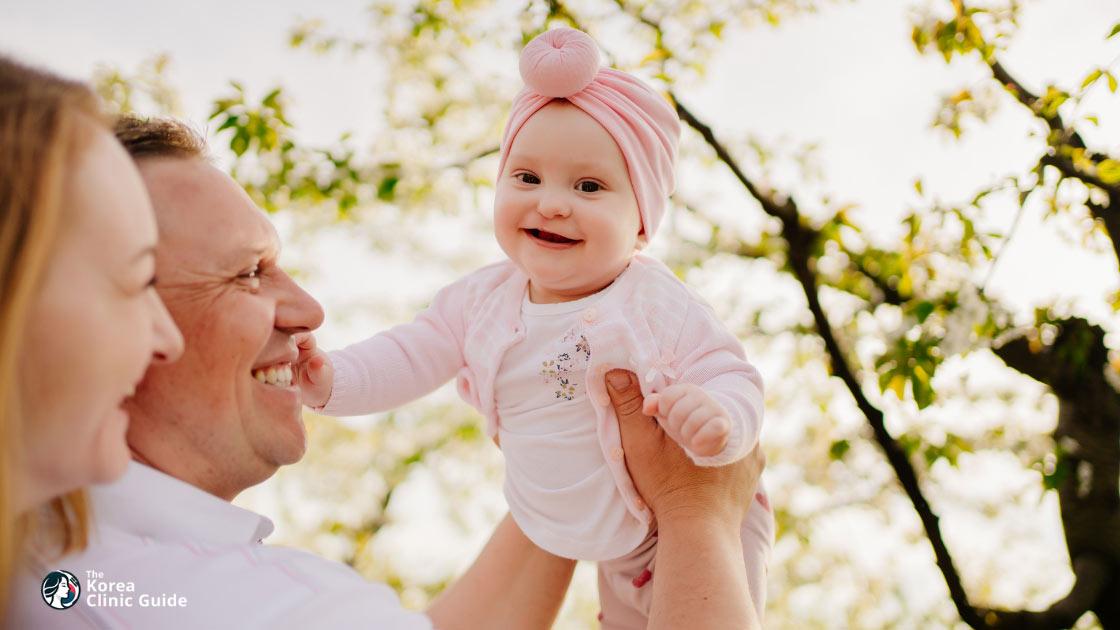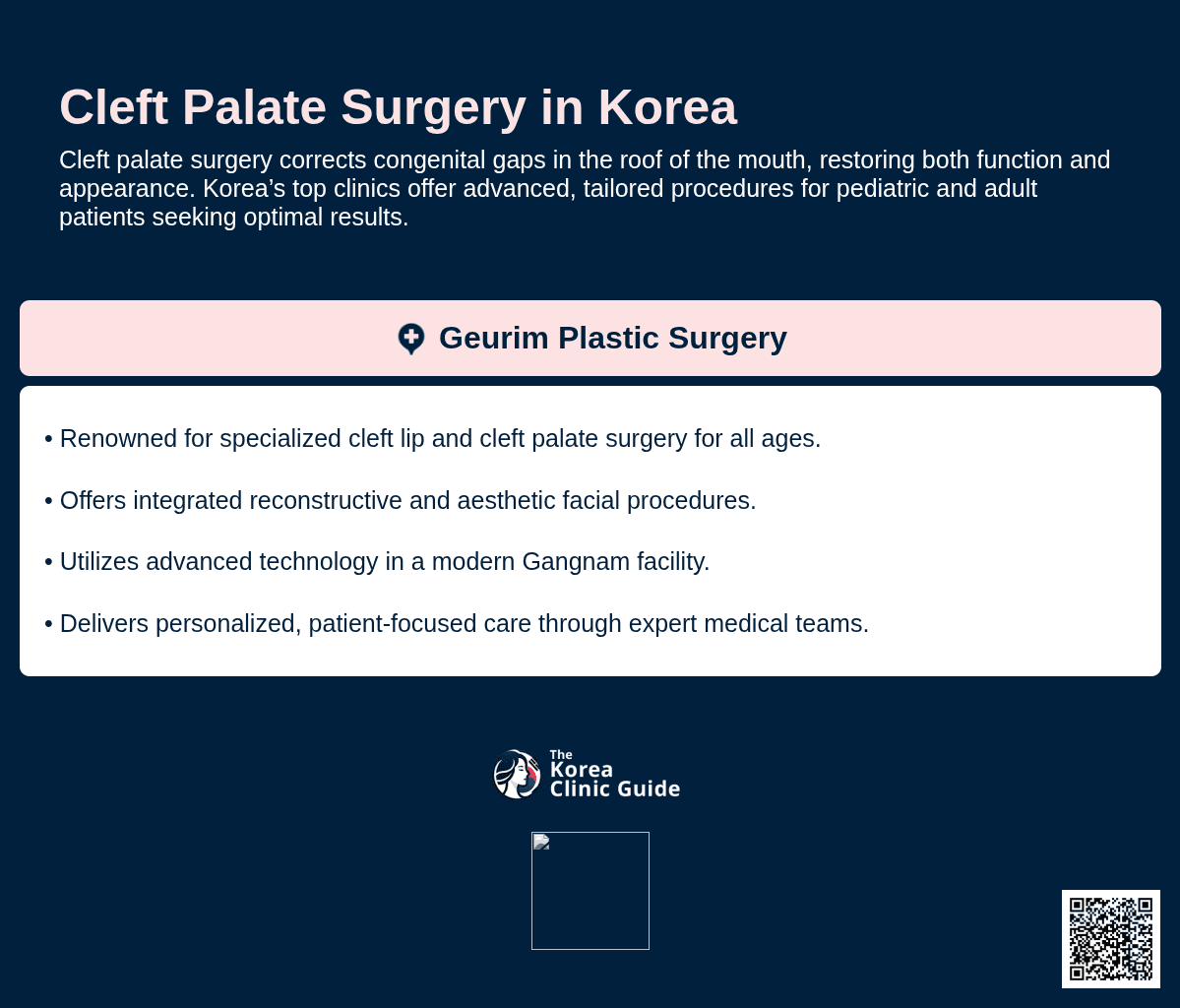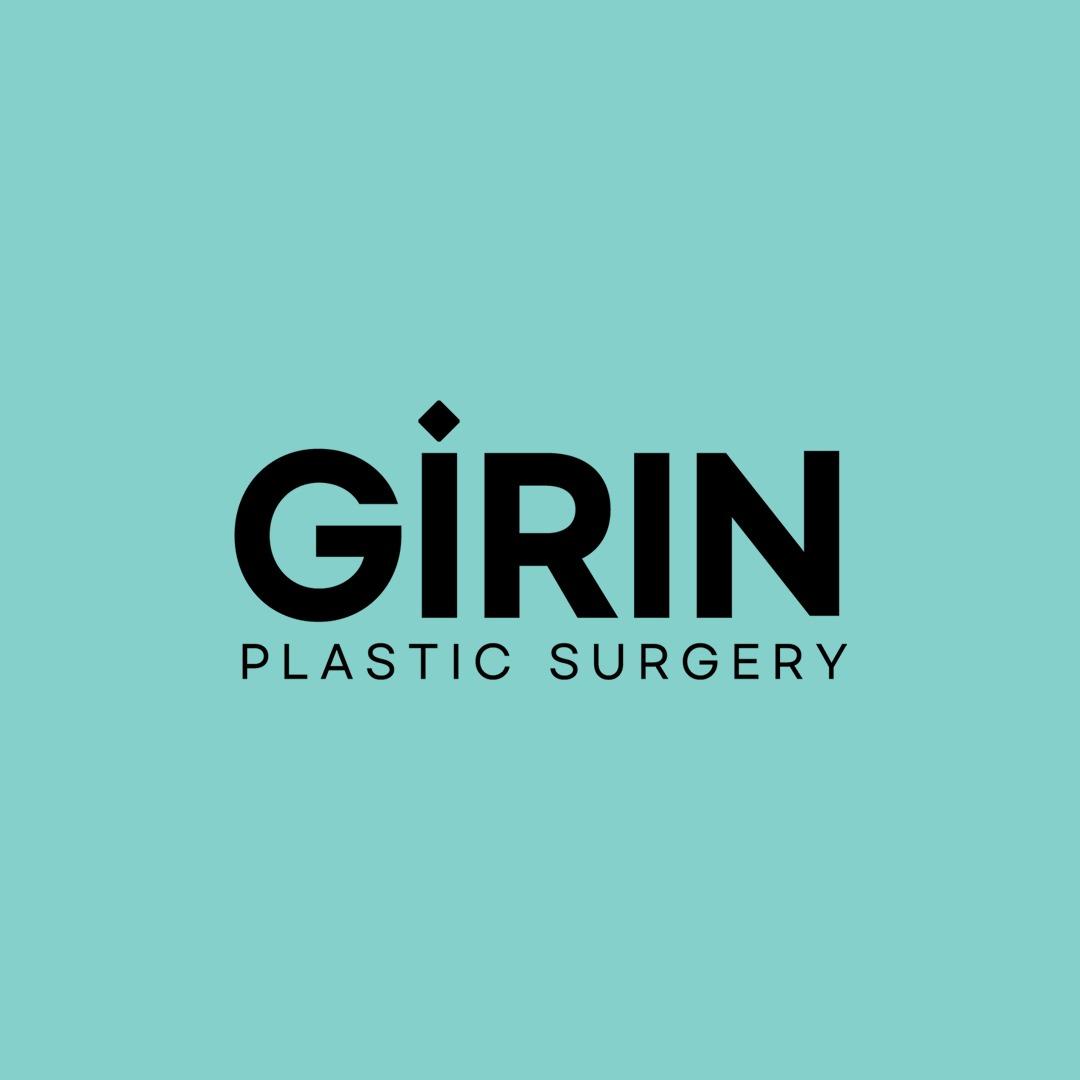Medical Tourism Blog
Cleft Palate Surgery in Korea | Best Clinics, Costs, Procedure Types & More

Table of contents
- What Is Cleft Palate Surgery?
- Best Clinics in Korea for Cleft Palate Surgery
- Getting Cleft Palate Surgery in Korea
- Cost of Cleft Palate Surgery in Korea
- Alternatives to Cleft Palate Surgery
- Conclusion
Considering treatment in Korea? Everything you need to know e.g. — how to avoid scams, visas, interpreters, recovery tips — in our Medical Tourism Master Guide. Plan with confidence in minutes, not weeks!
What if a single surgery could not only transform a smile but also drastically improve quality of life by enhancing speech and eating abilities? Cleft palate surgery does just that, and South Korea has become a top destination for this life-changing procedure due to its advanced medical facilities and skilled surgeons. This article explores the complexities of cleft palate surgery, the ideal candidates for the procedure, and the renowned clinics in Korea that are at the forefront of providing this vital transformation.
What Is Cleft Palate Surgery?
Cleft palate surgery, also known as palatoplasty, is a specialized surgical procedure aimed at correcting a congenital defect known as a cleft palate. A cleft palate is a condition where there is an opening or split in the roof of the mouth, which occurs when the tissue doesn't fuse together during fetal development. This defect can affect not only the aesthetic appearance of the child but also functions such as speech, eating, and breathing.
Objectives of Cleft Palate Surgery
The primary goals of cleft palate surgery are to:
- Close the opening: The most basic aim is to surgically close the gap in the palate.
- Restore function: Ensuring that the palate can function normally for speech, swallowing, and breathing.
- Improve appearance: Correcting the defect to improve facial structure and overall appearance.
The Procedure
Preoperative Planning
Before the surgery, a comprehensive evaluation is usually performed. This may include physical examinations, imaging studies, and consultations with various specialists like speech therapists and otolaryngologists (ENT doctors). This team-based approach helps create a customized surgical plan.
Types of Anesthesia
Cleft palate surgery is performed under general anesthesia, meaning the patient is completely asleep and will not feel any pain during the procedure.
Surgical Techniques
Several techniques can be employed depending on the specifics of the case:
-
Von Langenbeck Technique: One of the earliest techniques, it involves making incisions on either side of the cleft to bring the tissue together and close the gap.
-
Wardill-Kilner V-Y Pushback: This technique involves creating flaps of tissue that are repositioned to close the cleft while also lengthening the palate.
-
Furlow Double-Opposing Z-Plasty: This technique involves creating interlocking Z-shaped incisions that help in achieving both functional and aesthetic results by easing tissue tension and promoting better speech outcomes.
Postoperative Care
After the surgery, patients are closely monitored for complications such as bleeding, infection, or breathing difficulties. Pain management and feeding strategies are also crucial aspects of postoperative care. The child may need to stay in the hospital for a few days for observation.
Long-Term Care
Follow-up visits are essential to monitor healing and development. In some cases, additional surgeries may be needed as the child grows. Continuous speech therapy and dental care may also be necessary to ensure optimal outcomes. Regular assessments by a multidisciplinary team can help address any arising issues promptly.
Risks and Complications
Like any surgical procedure, cleft palate surgery carries some risks, including infection, bleeding, and adverse reactions to anesthesia. Specific complications related to this surgery may also include fistula formation (holes re-opening) and problems with speech or nasal function.
The success of cleft palate surgery dramatically improves the quality of life for affected individuals, enabling them to speak more clearly, eat properly, and develop self-confidence through improved facial aesthetics.
Who is Cleft Palate Surgery for?
-
Children with Cleft Lip or Palate: Surgery can help children born with a cleft lip or cleft palate, which are some of the most common birth anomalies worldwide. The surgery corrects the incomplete formation of the upper lip or roof of the mouth.
-
Individuals with Clefts on One or Both Sides of the Mouth: The condition can vary in severity and may involve one or both sides of the mouth. Surgery addresses these specific cases to ensure functionality and appearance.
-
Infants with Feeding Difficulties: Infants with a cleft palate often struggle to feed at the breast due to problems creating oral suction. Specialized bottles or feeding tubes might be required initially, with surgery resolving these feeding issues.
-
Children with Speech and Hearing Challenges: Cleft palate surgery helps improve the child's ability to speak, hear, and breathe, thus addressing any speech and hearing difficulties associated with the condition.
-
Patients Requiring Function Restoration: The surgery is not just cosmetic but also functional, restoring normal activity in the lips and mouth, allowing for better eating, speech development, and overall growth.
-
Those Needing Nasal Structure Corrections: Clefts of the upper lip can affect the shape of the nose. Nasal symmetry and nostril shape restoration can be part of the surgical process for better functionality and appearance.
-
Infants and Young Children: Timing for surgical intervention is typically at a young age, often between 2 and 6 months for cleft lip repairs and 9 to 18 months for cleft palate repairs, but may vary depending on individual health status and treatment protocols.
-
Cases with Uncertain Causes: While some clefts are syndromic, many are due to a complex interaction of genetic and environmental factors. However, surgery is beneficial regardless of the underlying cause.
-
Children Requiring Early Team Interventions: A multidisciplinary team including plastic surgeons, pediatricians, and speech-language pathologists among others, often manages the treatment plan. Such coordinated care ensures comprehensive management and successful surgical outcomes.
Best Clinics in Korea for Cleft Palate Surgery
Listed below are the best clinics in Korea for cleft palate surgery:
| Clinic Name | Key Features | Special Techniques |
|---|---|---|
| Geurim Plastic Surgery | Specialized expertise in cleft lip and palate surgery; comprehensive reconstructive services (scar revision, foreign body removal, correction of facial asymmetry); pediatric and adult care; cutting-edge technology; excellent reputation in Gangnam; holistic aesthetic approach; highly qualified medical team; personalized patient care | Advanced surgical techniques for cleft palate repair; tailored treatment plans for functional and aesthetic outcomes; integrated reconstructive and aesthetic procedures |
Geurim Plastic Surgery
Geurim Plastic Surgery, located in the heart of Gangnam, Seoul, is a distinguished clinic specializing in both aesthetic and reconstructive procedures. Renowned for its expertise in cleft lip and cleft palate surgery, Geurim Clinic provides comprehensive care for congenital and acquired facial anomalies, combining advanced surgical techniques with a patient-centered approach. The clinic is led by a highly experienced medical team and is equipped with state-of-the-art facilities, ensuring optimal outcomes and the highest standards of safety for all patients seeking reconstructive and cosmetic improvements.
Why Geurim Plastic Surgery is the Top Choice for Cleft Palate Surgery:
- Specialized Expertise: Geurim Clinic is acclaimed for its proficiency in cleft lip and cleft palate surgeries, offering tailored treatment plans that address both functional restoration and aesthetic harmony.
- Comprehensive Reconstructive Services: Beyond cleft repairs, the clinic provides a wide range of reconstructive options such as scar revision, foreign body removal, and correction of facial asymmetry, creating an integrated approach for patients with complex needs.
- Pediatric and Adult Care: The clinic successfully treats patients of all ages, adapting surgical techniques for both pediatric and adult cases to ensure long-term success and improved quality of life.
- Cutting-edge Technology: Geurim Plastic Surgery utilizes the latest surgical equipment and medical advancements, enhancing the precision and effectiveness of cleft palate repair.
- Reputation and Location: Situated in Gangnam, a hub for medical excellence in Seoul, Geurim Clinic enjoys an outstanding reputation among both domestic and international patients.
- Holistic Aesthetic Approach: With procedures spanning from facial contouring to smile enhancement, the clinic ensures that reconstructive surgery is complemented by aesthetic refinement, fostering both functional and psychological healing.
- Highly Qualified Medical Team: Patients are cared for by board-certified surgeons with extensive experience in complex reconstructive and aesthetic surgeries.
- Personalized Patient Care: Every patient at Geurim receives thorough pre-operative evaluation and post-operative follow-up, ensuring a safe, supportive, and satisfying treatment journey.
For those seeking the highest standards in cleft palate surgery and comprehensive facial reconstruction in Korea, Geurim Plastic Surgery stands out as a trusted and innovative choice.
Find more about this clinic here: Geurim Plastic Surgery Website
Getting Cleft Palate Surgery in Korea

Cleft palate surgery in Korea has garnered international attention due to the country's advanced medical technology, skilled surgeons, and comprehensive treatment protocols. This surgical intervention aims to correct a congenital deformity where the roof of the mouth (palate) fails to fuse properly during fetal development. Below is a detailed explanation of the entire process.
Pre-Surgical Evaluation
Before proceeding with the surgery, an extensive pre-surgical evaluation is conducted. This typically involves:
- Medical History Review: A thorough review of both the child's and family's medical histories to identify any potential genetic links or complications that may influence surgery.
- Physical Examination: A detailed physical check to assess the extent of the cleft and any related anomalies.
- Imaging Studies: Use of advanced imaging technologies like 3D CT scans to gain a comprehensive understanding of the defect.
- Multidisciplinary Consultation: Involving specialists such as pediatricians, speech therapists, orthodontists, and ENT specialists to develop a holistic surgical plan.
Surgical Procedure
Anesthesia
The procedure begins with the administration of general anesthesia to ensure that the child is pain-free and unconscious during the surgery.
Incision and Tissue Rearrangement
- Incision: The surgeon makes an incision along both sides of the cleft, creating flap-like sections of tissue.
- Closure: These tissue flaps are then rearranged to close the gap. The muscle and mucous lining are meticulously stitched, layer by layer, to form a natural palate. The use of absorbable sutures is common to eliminate the need for stitch removal later.
- Muscle Repositioning: In many cases, the muscles of the soft palate are also repositioned to function properly, enhancing speech and eating capabilities.
Post-Surgical Care
After the surgery, the child is moved to a recovery room where they are closely monitored. Postoperative care includes:
- Pain Management: Medications are provided to manage pain and discomfort.
- Feeding Instructions: Specialized feeding techniques and devices may be recommended to avoid disrupting the surgical site.
- Speech Therapy: Early intervention with speech therapy helps in developing normal speech patterns.
Follow-Up and Long-Term Care
Regular follow-up visits are essential to monitor the healing process and to address any complications such as infections, scarring, or the formation of fistulas. Long-term care often involves:
- Orthodontic Treatment: To correct any dental abnormalities.
- Additional Surgeries: Some children may require additional surgeries as they grow to further refine the cosmetic and functional aspects of the palate.
- Ongoing Speech Therapy: Continued speech therapy to ensure optimal language development.
Cutting-Edge Techniques
Korean medical institutions often employ cutting-edge techniques and technologies in cleft palate surgery, such as:
- Minimally Invasive Procedures: Using smaller incisions to reduce recovery time and scarring.
- Regenerative Medicine: Application of stem cell therapy and tissue engineering to enhance the healing process.
- Robotic Surgery: Utilizing robotic systems for greater precision in complex cases.
Cultural and Logistical Considerations
- Language Support: Many hospitals offer translation services to assist international patients.
- Medical Tourism Packages: Comprehensive packages often include accommodation, transportation, and guided tours to make the experience seamless for international visitors.
- Insurance and Costs: Detailed discussions about costs and insurance coverage are essential as these can vary significantly.
Korea's reputation for excellence in medical treatment, combined with its focus on patient-centered care, makes it an attractive destination for cleft palate surgery.
Cost of Cleft Palate Surgery in Korea
When considering cleft palate surgery, it's important to compare costs across different countries to ensure you are making an informed financial decision. Here's a comparative overview of cleft palate surgery costs in Korea, the United States, and other notable countries.
Korea
In Korea, the cost of cleft palate surgery is relatively affordable due to advanced healthcare infrastructure and government subsidization. On average, the surgery can range from $5,000 to $8,000. This price often includes pre-surgical consultations, the surgery itself, and post-operative care, making it an attractive option for both locals and international patients.
United States
In the United States, cleft palate surgery is significantly more expensive. The average cost ranges from $15,000 to $30,000, depending on the complexity of the case and the hospital or surgical facility. Insurance can cover a portion of the costs, but out-of-pocket expenses might still be substantial.
United Kingdom
In the United Kingdom, cleft palate surgery is typically covered by the National Health Service (NHS), which minimizes out-of-pocket costs for residents. For non-residents or those opting for private healthcare, the surgery can cost between £6,000 to £10,000 (approximately $7,500 to $12,500).
Alternatives to Cleft Palate Surgery
While cleft palate surgery remains a common and effective treatment for correcting cleft palate issues, there are several non-surgical alternatives for managing the condition. These alternatives can be utilized depending on the specific needs and health status of the child. Here are three recommended alternatives:
1. Specialized Feeding Devices
Specialized feeding bottles and nipples are designed to help infants with cleft palate feed better. These devices allow easier suction and minimize the risk of aspiration. Infants with cleft palate often have difficulty creating the necessary vacuum to suckle, making feeding a challenge. Specialized nipples and bottles can help mitigate these difficulties by allowing milk or formula to flow with less effort.
- Advantages: Non-invasive, immediately available, and can significantly improve an infant's nutrition and overall health.
- Limitations: They do not correct the cleft itself and are a short-term solution.
2. Speech Therapy
Speech therapy is an essential component of cleft palate management, particularly for children with speech and language development issues. Speech therapists can employ techniques to improve articulation, resonance, and overall speech quality. Early intervention is crucial for the best outcomes.
- Advantages: Empowers children with better communication skills, can be started at a young age, and is non-invasive.
- Limitations: It does not address the anatomical cause of the cleft and may require long-term therapy sessions.
3. Orthodontic Treatments
Orthodontic procedures, such as NasoAlveolar Molding (NAM), can help in cases where surgical intervention may need to be delayed. NAM involves the use of a custom-fitted appliance to gradually mold and shape the gums, lip, and nose before surgery. This treatment can significantly improve the results of subsequent surgical repairs.
- Advantages: Prepares the tissues for surgery, leading to better post-operative outcomes, and can sometimes reduce the number of surgeries needed.
- Limitations: Requires regular adjustments and visits to the orthodontist, and does not substitute for surgery.
By combining these alternatives with a multidisciplinary team approach, including pediatricians, surgeons, orthodontists, and speech therapists, many children with cleft palate can achieve improved health outcomes and quality of life.
Conclusion
In conclusion, cleft palate surgery in Korea stands out for its advanced medical technologies, highly skilled surgeons, and comprehensive post-operative care. The country's commitment to medical excellence ensures that patients receive not only effective surgical intervention but also holistic support throughout the recovery process. With Korea’s integration of state-of-the-art facilities and extensive patient support systems, the outcomes for individuals undergoing cleft palate surgery are markedly positive, enhancing both function and aesthetics. For families seeking high-quality medical care for cleft palate conditions, Korea represents a leading destination, promising both expertise and compassionate care.









